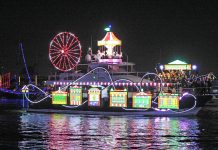The California Coastal Commission unanimously approved two Newport Beach dredging related items and the city’s Eelgrass Protection and Mitigation Plan during their meeting last week.
The city applied for a Coastal Development Permit and Federal Consistency Certification to continue it’s small dredging and beach replenishment program within the urbanized harbor areas of Newport Bay.
Both also included the proposed Eelgrass Protection and Mitigation Plan for eelgrass impacts.
“This plan is a bit of a departure from our typical project by project review and mitigation,” said CCC Analyst Zach Rehm.
It’s an expanded version of a program previously approved by the commission, Rehm explained. This program would be authorized for an additional six years.
It will allow the city primary permitting responsibility for small maintenance dredging projects (up to 8,000 cubic yards per event) within a designated area, most of which is in Lower Newport Bay. The plan would also apply to the bulkheaded areas of Dover Shores, Bayside Village and existing docks at Shellmaker Island.
The program permit would only allow dredging under existing small dock facilities. The demolition, repair and replacement of docks, bulkheads and piles would still require a CDP from the commission.
Suitable dredged material would be used to replenish beaches in front of bulkheads and at street ends throughout the bay. Dredged material unsuitable for beach replenishment would be disposed of at existing authorized ocean disposal sites.
The federal consistency certification would authorize dredging up to 75,000 cubic yards per year (8,000 cubic yards per dredging event). It includes offshore disposal of the material.
The plan allows for more dredging than the plan which has been in place since 1999, Rehm said.
The new program is also different from because it would permit temporary impact to eelgrass, he continued. Those impacts would be subject to the city’s Eelgrass Protection and Mitigation Plan, he added. The impacts will only be temporary, he emphasized. There will also be careful monitoring along the way, he added.
The harbor is a hugely important asset for the city and the state, both economically and environmentally, said Don Schmitz of Schmitz and Associates, representing the city.
“We need a plan, commissioners, because our harbor is silting up,” Schmitz said.
The small marinas and private dock owners don’t have the time or resources to go through the lengthy process of dredging projects, Schmitz said.
“What we’ve noticed is that before people even get started with the application process, they just give up,” Schmitz said.
After years of this, all the silt builds up, he explained.
The city has come up with a revolutionary ecosystem-based approach, Schmitz said. The city has done extensive harbor-wide surveys of the eelgrass beds, he explained.
“Every little blade of eelgrass has been mapped in Newport Harbor,” Schmitz said.
The studies have shown that the there is an ebb and flow in the amount of eelgrass in the harbor.
“It is a better thing for the environment. It’s a more holistic, comprehensive understanding,” Schmitz said. “It will allow us to maintain the crucial harbor resources in Newport Beach.”
The plan will help the city more effectively manage this resource in a way that makes sense, said Steve Rosansky, Newport Beach Chamber of Commerce president and CEO, and former mayor and councilman.
Another former mayor, Nancy Gardner also spoke in support of the plan.
A lot of boaters look at eelgrass as their nemesis because they can’t dredge. This plan will hopefully turn them into friends of eelgrass, said Gardner, who has also been involved with several environmental organizations.
“This is a good plan,” Gardner said. “It really balances the harbor needs with the environmental needs.”
Steve Bone, chairman of the board of Orange County Coastkeeper, agreed.
The organization has been working to protect and ensure an abundance of eelgrass as a habitat for fish. The proposed plan will help in that effort, he said.
Even lifelong Newport Beach resident and avid harbor user Seymour Beek spoke in support of the city’s plan. He also gave a brief history of eelgrass.
Growing up in Newport, there was a lot of eelgrass, Beek recalled. It began to diminish in the 1960s and 1970s and there was essentially none left in Newport by 1990, he noted.
“You couldn’t find a blade of it anywhere,” Beek said.
Then it miraculously came back sometime in the 1990s and was all over the place by 2000 and continued to grow since then.
“My personal opinion is that it doesn’t require a lot of protection, it’s going to be ok,” Beek said.
This mitigation plan does everything it needs to do, he said. The eelgrass will be well taken care of under this plan, Beek added.
The commissioners agreed with the public speakers and approved both items unanimously after a brief discussion.
“It’s a rather breakthrough program which will hopefully allow eelgrass and fish and boaters and the marina and homeowners to learn to live in peace with love for each other,” which has not always been the case when it comes to marinas and eelgrass, said Commissioner Mary Shallenberger.
For more information, visit newportbeachca.gov.




